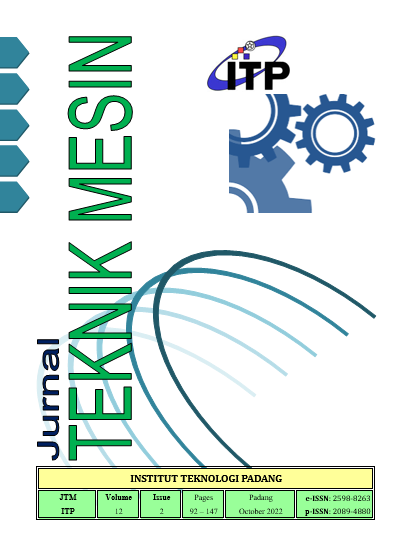Measurement of the sound absorption coefficient of palm frond fiber composites with synthetic adhesives
DOI:
https://doi.org/10.21063/jtm.2022.v12.i2.131-137Kata Kunci:
composite, palm fronds fiber, acoustic properties, sound absorption coefficients, volume fractionAbstrak
Natural fiber composite materials have been widely applied for various purposes, one of which is reducing noise. Many efforts have been tried to reduce noise by using sound absorbing materials such as glasswool, rockwool, and gypsum as sound absorbers, but because of the high price and bad impact on health, many studies have been conducted to find materials that are practical, cheap, and abundant availability in nature, one of which is natural fiber as an alternative to commercial sound absorbing materials. In this study, we want to know the effect of the composition of palm fronds with polyester resin can affect the sound absorption of a material and the effect of composition on sound absorption. The composition of palm frond fiber and polyester resin was varied 60%:40%, 65%:35%, 70%:30%, 75%:25%, 80%:20%, 85%:15%, 90%:10%, arranged randomly with a length of 5 mm. The specimen synthesis process starts with cutting the palm fronds, decomposing the palm frond fibers so that the fibers are separated from the flesh. Acoustic testing was conducted using a single microphone impedance tube. The test results showed that the largest absorption coefficient value is 0.984 at a frequency of 1500 Hz and is obtained in materials with a composition of 70%: 30%, and for the largest acoustic impendance value is 1.714 which is found at a frequency of 500 Hz and is obtained in the composition of 85%: 15%.
Referensi
M. Y. R. Siahaan and D. Darianto, “Karakteristik Koefisien Serap Suara Material Concrete Foam Dicampur Serat Tandan Kosong Kelapa Sawit (TKKS) dengan Metode Impedance Tube,” JOURNAL OF MECHANICAL ENGINEERING MANUFACTURES MATERIALS AND ENERGY, vol. 4, no. 1, pp. 85–93, Jun. 2020, doi: 10.31289/jmemme.v4i1.3823.
F. Zulhiyah and dkk, “Analisis Perbandingan Nilai Efektivitas Koefisien Absorbsi pada Pelepah Pisang dan Eceng Gondok,” Samarinda, Dec. 2022.
S. Amares, E. Sujatmika, T. W. Hong, R. Durairaj, and H. S. H. B. Hamid, “A Review: Characteristics of Noise Absorption Material,” in Journal of Physics: Conference Series, Oct. 2017, vol. 908, no. 1. doi: 10.1088/1742-6596/908/1/012005.
A. Z. M. Rus, N. M. H. Nik, and R. A. B. Rahim, “Influence of multilayer textile biopolymer foam doped with titanium dioxide for sound absorption materials,” in Key Engineering Materials, 2014, vol. 594–595, pp. 750–754. doi: 10.4028/www.scientific.net/KEM.594-595.750.
“HIGH PERFORMANCE SOUND ABSORPTION FOR A QUIETER ENVIRONMENT • Optimal performance at lower thickness • Excellent sound absorption behaviour • Easy application and low maintenance • Designed for use in demanding environments.” [Online]. Available: www.tcpdf.org
A. M. A. Zaidi, M. I. bin Ghazali, M. N. bin Yahya, and M. Ismail, “Investigation on sound absorption of rice-husk reinforced composite,” 2009.
C. W. Lou, J. H. Lin, and K. H. su, “Recycling Polyester and Polypropylene Nonwoven Selvages to Produce Functional Sound Absorption Composites,” Textile Research Journal, vol. 75, no. 5, pp. 390–394, 2005, doi: 10.1177/0040517505054178.
N. N. M. Hassan and A. Z. M. Rus, “Influences of thickness and fabric for sound absorption of biopolymer composite,” in Applied Mechanics and Materials, 2013, vol. 393, pp. 102–107. doi: 10.4028/www.scientific.net/AMM.393.102.
S. J. Wertel, “EXPERIMENTAL ANALYSIS OF NOISE REDUCTION PROPERTIES OF SOUND ABSORBING FOAM,” 2000.
I. M. Astika and I. M. G. Karohika, “Pengukuran Koefisien Serapan Suara pada Komposit Serat Tapis Kelapa,” Prosiding Konferensi Nasional Engineering Hotel III, Universitas Udayana, pp. 357–364, 2012.
E. Indrawati and M. Tirono, “Koefisien Penyerapan Bunyi Bahan Akustik Dari Pelepah Pisang dengan Kerapatan yang Berbeda,” Jurnal Neutrino, vol. 2, no. 1, pp. 32–39, 2009.
N. Hafifah and H. Artikel, “Pemanfaatan Limbah Daun Nanas (Ananas Comosus) Untuk Panel Akustik Sebagai Absorpsi Kebisingan,” Jurnal Fisika Unand (JFU), vol. 11, no. 4, pp. 467–473, 2022, doi: 10.25077/jfu.11.4.467-473.2022.
P. Aceh, S. Tapaktuan, and A. Selatan, “KARAKTERISTIK AKUSTIK PANEL SERAT AREN DENGAN BAHAN PEREKAT LATEX Lindawati,” Jurnal Inotera, vol. 2, no. 1, 2017.
P. Pratiwi, H. Fahmi, A. Yanto, and I. Fitra Soni, “The Effect of Volume Fraction on Acoustic Properties of Areca Nut Midrib Fibers Composites with Natural Adhesives,” Jurnal Teknik Mesin, vol. 10, no. 2, pp. 102–108, Oct. 2020, doi: 10.21063/jtm.2020.v10.i2.102-108.
R. N. Harahap, “Kajian Eksperimental Karakteristik Material Akustik Dari Campuran Serat Batang Kelapa Sawit Dan Polyurethane Dengan Metode Impedance Tube,” Universitas Sumatera Utara, Medan, 2010.
S. Putra Wirman and Y. Fitri dan Wildo Apriza, “KARAKTERISASI KOMPOSIT SERAT SABUT KELAPA SAWIT DENGAN PEREKAT PVAc SEBAGAI ABSORBER,” Juni, vol. 1, pp. 10–15.
E. Yuliza and R. Ekawita, “STUDI AWAL PENGEMBANGAN PAPAN KOMPOSIT BERBASIS LIMBAH PELEPAH SAWIT SEBAGAI MATERIAL AKUSTIK,” JoP, vol. 5, no. 1, pp. 1–5, 2019.
A. Rizal, Y. Fitri, J. Fisika, F. dan Kesehatan, and U. Muhammadiyah Riau, “KARAKTERISTIK ABSORBSI DAN IMPEDANSI MATERIAL AKUSTIK SERAT ALAM AMPAS TAHU (GLYCINE MAX) MENGGUNAKAN METODE TABUNG.”
F. Ridhola and Elvaswer, “Pengukuran Koefisien Absorbsi Material Akustik dari Serat Alam Ampas Tebu Sebagai Pengendali Kebisingan,” Jurusan Fisika FMIPA Universitas Andalas, Indonesia, vol. 7, no. 1, pp. 1–6, 2015
Unduhan
Diterbitkan
Terbitan
Bagian
Lisensi
Hak Cipta (c) 2022 Putri Pratiwi, Abdul Rahman, Asmara Yanto

Artikel ini berlisensiCreative Commons Attribution-NonCommercial-ShareAlike 4.0 International License.


